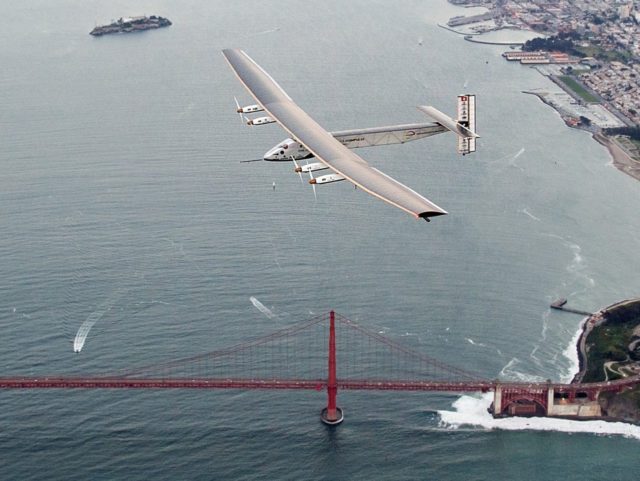The Solar Impulse 2 flew from Hawaii’s Kalaeloa Airport to Google-controlled Moffett Airfield in 62 hours this week, providing proof-of-concept that solar-powered drones will soon be bringing 5G wireless communications to the world without a drop of fossil fuel.
The Swiss-based effort began in 2009 and has consistently raised the necessary funds and achieved the technical milestones for the team of over 100 to support the 12-stop journey of approximately 4,000 miles.
Piloted by explorer and psychiatrist Bertrand Piccard, the Solar Impulse 2 broadcast some spectacular evening pictures flying over San Francisco’s Golden Gate Bridge and other viewpoints before touching down at Google’s Spaceport America at midnight.
“It’s a new era. It’s not science fiction. It’s today,” Piccard told CNN after his successful trip. “It exists and clean technologies can do the impossible.”
The Solar Impulse 2 has a 236-foot wingspan to support a large surface of photovoltaic cells that charge four nacelles, each with a set of lithium polymer batteries. Stored energy powers four 10 horsepower electric motors that spin twin-bladed propellers.
Each of the electric motors over an optimum 24-hour cycle can produce about the same thrust as the 1903 Wright Brothers Flyer for an average cruising speed of about 40 miles an hour.
Although the clean energy crowd cheered the accomplishment as the first demonstration that modern man can operate free of fossil fuels, the real commercial value of the Solar Impulse is proof of concept for Google’s “Project SkyBender” initiative to deliver “Fifth Generation” (5G) Internet by solar-powered airborne drones.
The SkyBender initiative is part of Google’s Access and Energy unit, which focuses on Internet connectivity projects to provide super-fast Internet link-ups. Other airborne drone projects run by Google’s X Division include Project Wing drones and Project Loon high-altitude balloons.
By 2020, Google plans to start offering 5G wireless millimeter-wave radio technology that operate at speeds up to a thousand times faster than current 4G technologies. Google intends to deploy its drone units form a “connectivity backbone” for 60 percent of the global population.
Google’s rapid progress forced Facebook to acquire aerospace firm Ascenta in 2014 to create its own capability to deliver 5G Internet connections via solar-powered drones.

COMMENTS
Please let us know if you're having issues with commenting.